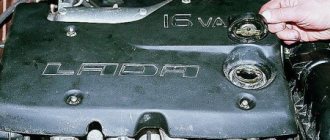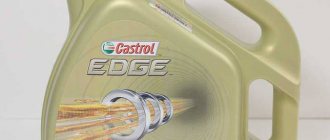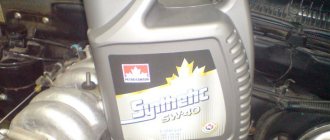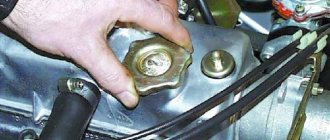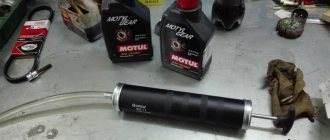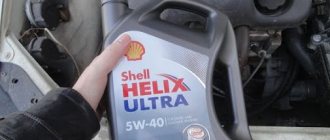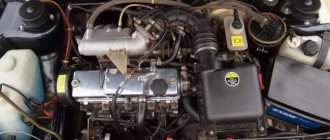VAZ-2107 is a classic car, which is an updated version of the VAZ-2107 from the 1970s. Since those times, the design of the machine has essentially not changed. But on the other hand, this can be considered an advantage, since the VAZ-2107 is well suited for independent maintenance - this can be confirmed by the fact that such cars are almost never available at Lada branded dealership centers. The owners serve them themselves, without much effort. And since there are a lot of such people, that means there are a huge number of questions about service. For example, the most popular of them is how much oil to fill in the VAZ-2107 engine. In addition, novice and experienced owners of the car in question are interested in information on the choice and type of oil, as well as the frequency of replacement.
Replacement Regulations
The manufacturer advises changing the engine oil in the VAZ-2107 engine every 10 thousand kilometers. But this is a conditional indicator that can be reduced or increased depending on the condition of the oil. For example, if it darkens and stinks ahead of schedule, then an oil change will be required at the 6th or 7th thousand. Since the VAZ-2107 is an unpredictable car, the rule is that it is better to change the oil in advance. If you are late with an oil change, you may face irreversible consequences. It may come down to a major overhaul of the engine. But on the other hand, the oil can last for 15 thousand kilometers if the car is operated in favorable climatic zones - for example, on good roads, in warm weather, and without frost.
The most popular articles on the site:
- How often should you change engine oil?
- Oil 5w30 and 5w40 what is the difference
- What oil to pour into the engine in winter and summer
- How long does it take to change the automatic transmission oil?
HOW THE OIL FILTER IS DESIGNED FOR VAZ 2107
When changing the oil on a VAZ 2107, car owners usually also replace the oil filter. Let's try to figure out what kind of device this is and what it comes in. Oil filters are divided into three types:
- filters with modular housing;
- filters with a collapsible housing;
- filters with a non-separable housing.
The most expensive are collapsible filters. But at the same time they also have the longest service life. When a filter of this type becomes clogged, the car owner removes it, opens the housing, removes the filter element and replaces it with a new one.
Filters with non-removable housings do not last long because they are disposable devices. As soon as the filter elements in such a filter become dirty, the car owner simply throws it away.
A filter with a modular housing is a hybrid of a collapsible and non-separable filter. The modular housing is only partially disassembled, so the car owner only has access to the filter element. The remaining filter parts remain inaccessible.
The filter housing can be anything you want, but the “filling” of this device is almost always the same.
The filter housing may be different, but its “filling” is always the same
The body always has the shape of a cylinder. There are two valves inside: forward and reverse. There is also a filter element inside connected to a spring. On the outside of each filter there is a small rubber O-ring. It prevents oil leakage.
The filter element is made of filter paper with special impregnation. This paper is folded many times, so that a kind of “accordion” is formed.
A paper “accordion” allows you to increase the filter surface area by 28 times
This technical solution is necessary to ensure that the filter surface area is as large as possible. The direct valve allows oil to enter the engine when the main filter element is clogged. In fact, the straight valve is an emergency device. It lubricates the rubbing parts of the engine with unrefined oil. And when the car engine stops, the check valve comes into play. It traps oil in the filter and prevents it from flowing back into the crankcase.
Thus, the choice of oil filter for the VAZ 2107 depends entirely on the car owner’s wallet. Anyone who wants to save money chooses a non-separable filter. Those who are not constrained by funds install collapsible or modular devices. A good option here is a filter from MANN.
MANN is perhaps the most popular collapsible oil filter among VAZ 2107 owners
Modular devices from CHAMPION are also in constant high demand among owners of “Sevens”.
The CHAMPION filter is cheaper than MANN, but has a modular design
Well, if money is short, then you can take a closer look at the Nf-1001 disposable filters. As they say, cheap and cheerful.
Disposable filter Nf-1001 will help out the driver who is tight on money
ABOUT THE FREQUENCY OF REPLACING OIL FILTERS
If you look at the VAZ 2107 operating instructions, it says that oil filters should be changed every 8 thousand kilometers. The problem is that mileage is far from the only criterion by which the wear and tear of a device is determined. You can tell if the filter is worn out by checking the engine oil. If a car owner, checking the oil with a dipstick, sees dirt on the dipstick, it means the filter is not working well and needs to be replaced. The life of the filter is also affected by the driving style of the car. If the car is driven too aggressively, the oil filters become clogged faster. Finally, the operating conditions of the car. If the car owner has to constantly drive in heavy dust, then the oil filters will have to be changed very often.
Which oil to choose
Before you know the oil volume, you should pay attention to the most important oil parameters. We are talking about viscosity characteristics, as well as the API quality grade, which is designated as the letters SH, SH, SJ and SL. As for viscosity, here we need to take into account the set of numbers before and after the letter W. For example, the first number (before the W) indicates the cold start temperature, and the second indicates the viscosity. If the car is new, the viscosity should be at the level of -30, and with 100 thousand mileage - 50. If the mileage is even higher, then a viscosity with a figure of 60 or more is suitable.
As for choosing a brand, it all depends on brand preferences. But it is advisable to choose among well-known companies. Among the most trusted companies, we note Shell, Lukoil, Mobile, Castrol, Texaco and Motul.
VAZ-21074 injector: the last of the “classics”
The latest classic version of the Zhiguli was the VAZ-21074, which later became one of the most popular Soviet and then Russian cars. The VAZ-21074 injector was greeted by numerous admirers of the “seventh” model with undisguised enthusiasm, and, by and large, the car as a whole met the expectations of car enthusiasts. At the time of release, the car was considered the fastest rear-wheel drive sedan of the models previously produced by the Volzhsky Automobile Plant. In 2006, in order to comply with environmental safety conditions and improve technical parameters, an injection engine began to be installed on the VAZ-21074.
Types of oil
- Synthetic is the thinnest oil. Due to its fluidity, such a liquid is very resistant to low temperatures and never freezes in cold weather. Recommended for new cars, including VAZ-2107 with low mileage.
- Mineral oil is the cheapest and thickest oil. Perhaps these are all its advantages. Not suitable for low temperatures, but it will be the best option for cars with high mileage.
- Semi-synthetic is a cheaper oil than pure synthetics. But at the same time, its advantages pale in comparison to real synthetic oil. And yet, semi-synthetic is definitely better than mineral oil. Considering the fact that the car is cheap, this oil is suitable for it.
How much to fill
The volume of fluid poured is very important during the oil change process, because underfilling or overfilling can negatively affect engine reliability. So, for the VAZ-2107, about 4 liters of new semi-synthetic oil are recommended. This is how much oil should be included during a complete change, that is, with a comprehensive flush. If a partial replacement is made, you will have to fill in a little less oil, since the old fluid will still remain in the engine.
Sources
- maslospec.ru/skolko-masla-v-dvigatele-vaz-2107.html
- bumper.guru/klassicheskie-modeli-vaz/dvigatel/zamena-masla-v-dvigatele-vaz-2107.html
- rmark.ru/302/lada/2107/
- drive2.ru/l/288230376153061080/
- ladaautos.ru/vaz-2107/vaz-2107-skolko-masla-zalivat.html
Review of the VAZ-21074 injector model
The beginning of serial production of VAZ-21074 cars dates back to 1982, when the first copies of this model rolled off the assembly line of the Volzhsky Automobile Plant. At that time, the car was equipped with a carburetor power system: the injector on the VAZ-21074 appeared only in 2006. The advantages of the injection method of fuel supply are no longer a revelation to anyone, and after this system was implemented on the VAZ-21074:
- the engine began to start better in conditions of negative temperatures, without requiring prolonged warm-up;
- at idle speed the engine began to operate more smoothly and quietly;
- fuel consumption has decreased.
The disadvantages of the VAZ-21074 include:
- low location of the exhaust pipe catalyst, which increases the risk of damage to this expensive part;
- inaccessibility of some parts and sensors, which was a consequence of the fact that the old type of body was not designed for an injection system - in the carburetor version there is much more space under the hood;
- low level of noise insulation, which reduces the level of comfort of the car.
The presence of a computer control unit allows you to respond in a timely manner to the occurrence of malfunctions, since a signal about a breakdown is immediately sent to the instrument panel. The control circuit for the operation of the engine and its systems used in the VAZ-21074 allows you to control the composition of the fuel mixture, turn the fuel pump on and off using electronics, and continuously monitor all components and mechanisms.
The control scheme includes:
- Motor diagnostic block;
- Tachometer;
- Control system fault monitoring lamp;
- Throttle sensor;
- Throttle valve;
- Radiator cooling fan;
- Fan relay;
- Control block;
- Ignition coil;
- Speed sensor;
- Ignition section;
- Temperature sensor;
- Crankshaft sensor;
- Fuel pump relay;
- Fuel tank;
- Gasoline pump;
- Bypass valve;
- Safety valve;
- Gravity valve;
- Fuel filter;
- Canister purge valve;
- Reception pipe;
- Oxygen sensor;
- Battery;
- Egnition lock;
- Main relay;
- Nozzle;
- Fuel pressure control;
- Idle air control;
- Air filter;
- Air flow sensor.
A plate with identification data of the VAZ-21074 car can be found on the bottom shelf of the air intake box, which is located under the hood near the windshield, closer to the passenger seat. Next to the plate (1) is stamped VIN (2) - the vehicle identification number.
The passport data on the plate is:
- Parts number;
- Manufacturing plant;
- Indication of conformity and vehicle type approval number;
- An identification number;
- Power unit model;
- Maximum permissible force on the front axle;
- Maximum permissible load on the rear axle;
- Version and equipment;
- Maximum permitted vehicle weight;
- Maximum permitted weight with trailer.
The alphanumeric characters on the VIN number mean:
- the first three digits are the manufacturing plant code (in accordance with international standards);
- the next 6 digits are the VAZ model;
- Latin letter (or number) - year of manufacture of the model;
- the last 7 digits are the body number.
